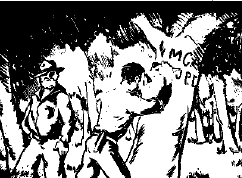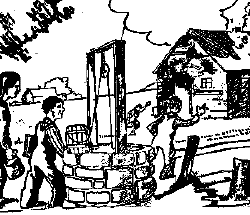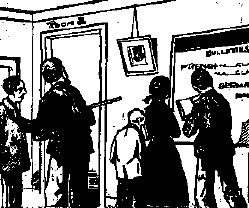
- John Polk Campbell Leaves His Mark
- State Authorizes Public Schools
- Private Schools Open
- Law on School Strengthened
- School Lacking For Colored Children

To get the complete picture of the history of education in Springfield, Missouri, one must go back to the early 19th Century. (See the Timeline to place things in perspective.)
The importance of schooling was demonstrated when, on June 10, 1808, the Territorial Legislature of Louisiana, meeting in session at New Orleans, passed an Act to legally organize a school in St. Louis.
Four years after the first school in St. Louis, an Act of the United States Congress made Missouri a territory. The 1812 legislation said, "Schools and the means of education shall be encouraged and provided for from the public lands of the United States within the Missouri Territory." On June 30, 1817, St. Louis incorporated into a special school district with seven trustees. Congress donated land by taking it from the United States Common Lands within and near the town.
No other known public schools existed, but private and church schools were plentiful throughout the Missouri Territory.
During the territorial years several thousand pioneer white and many Spanish and French men lived in the new Missouri Territory. A few from these various races were in the southwest area.
The earliest white explorers to leave a record of their visit were Henry Rowe Schoolcraft and Rufus Pettibone. Schoolcraft's notes say their 1818-19 adventure into the interior of Missouri and Arkansas led them to an "elevation on the principal northwestern source of the White River," or at the present Ozark bridge just south of Galloway.
The Pettibone family came up the White River in the 1820's and landed at the mouth of today's James River. Traders like William Gillis, James Wilson and a few runaway slaves also lived along the river.
Many Indians from the Osage, Kickapoo and Delaware tribes lived in the southwest area at various times. Their scattered villages and burial grounds disappeared after the 1812 and 1825 Treaties claimed their land.
It was another and more famous Act by the 1820 United States Congress making Missouri a state which stimulated the formation of public schools. The Act stated in part, "Schools should be forever encouraged in the new state," and "the legislature shall take steps to preserve from waste or damage such lands as have been or shall hereafter be granted for the use of schools." The law further provided, "One or more schools shall be established in each Congressional Township as soon as necessary, and the children of the poor shall be taught free."
An amended law on January 17, 1825, by the Missouri General Assembly provided for each Township school to be under the control of the County Court.
At that time every Missouri county covered large, lawless areas of land. Greene County, organized in 1833 and named to honor Nathanael Greene of Revolutionary War fame, covered the entire southwest area of the state. There were no known organized township schools in all of Greene County.
 JOHN POLK CAMPBELL LEAVES HIS MARK
JOHN POLK CAMPBELL LEAVES HIS MARK![]()
Nine years after Missouri became a state, John Polk Campbell came by horseback from Tennessee. He crossed the southwest area of the state to a prairie occupied by Kickapoo Indians. On a forested elevation he found a natural well. He liked the surroundings and the climate. After camping a few days, Campbell carved his initials, JPC, on an ash tree and returned to Maury County, Tennessee, for his family.
When Campbell came back the next year he found A. J. Burnett and his family living in a cabin near the ash tree bearing Campbell's initials. Burnett graciously relinquished the ash tree, land, and his cabin to Campbell. The Burnetts then built another cabin on the north side of Olive Street between Boonville and Robberson avenues.
During that first year of 1830, three Fulbright brothers, William, John, and Levi came over the Kickapoo prairie and settled near the Campbells and Burnetts. Together they formed a little town and called it Springfield.
It was the arrival of the Joseph Rountree family that same year which resulted in the birth of the first schools in the new town. The Rountree family caravan crossed the Mississippi River on Christmas Eve of 1830. It took five ferry trip efforts to get the wagons over the ice-heavy river. Three weeks later they reached the camp site around the "natural spring". Rountree wrote in his diary that it is with "Great Joy" that they greeted the others there.
 Later that summer Rountree opened a school about a mile west of the natural well settlement. The school was a "rude little log cabin on a pleasant slope, facing toward the northeast and down toward the Jordan Creek." The first Springfield school had a dirt floor, one log cut out for a window, no shutter to the door, and no chimney. The "frontier children wriggled on the three-legged split-log stools as they learned to cipher and spell." When the weather was good, the children looked through the open door toward the inviting Jordan Creek. When it was windy, rainy and cold they shivered in discomfort and huddled around the fireplace (without an outside chimney.) About twenty pupils, including Henry Fulbright and his younger brothers, the Rountree boys, J. J. Weaver, and Louisiana and Jane Weaver paid $1.00 a month to attend the first school. 1
Later that summer Rountree opened a school about a mile west of the natural well settlement. The school was a "rude little log cabin on a pleasant slope, facing toward the northeast and down toward the Jordan Creek." The first Springfield school had a dirt floor, one log cut out for a window, no shutter to the door, and no chimney. The "frontier children wriggled on the three-legged split-log stools as they learned to cipher and spell." When the weather was good, the children looked through the open door toward the inviting Jordan Creek. When it was windy, rainy and cold they shivered in discomfort and huddled around the fireplace (without an outside chimney.) About twenty pupils, including Henry Fulbright and his younger brothers, the Rountree boys, J. J. Weaver, and Louisiana and Jane Weaver paid $1.00 a month to attend the first school. 1
The next year Rountree built a better log school house on the northwest corner of now Main Avenue and the "west" road. The "west" road led from the Square after Campbell laid out the townsite in 1835. This more modern school had "a loose plank floor, a door shutter, and a mud and stick chimney." Rountree's log school was later the site for a Christian church that included a "subscription" school.2
STATE AUTHORIZES PUBLIC SCHOOLS![]()
The same year Campbell donated and measured off 50 acres of land for the Public Square, the Legislature authorized the governor to form a system of common and primary schools. As a result, the Eighth General Assembly provided: "1) a state board of education; 2) for schools to continue six months in each year; 3) for school expenses to be paid out of school funds of each county; 4) for people of each county, by a two-thirds majority vote, to tax themselves three and one-third cents dollars for school purposes; 5) a Board of three trustees for each district to make needful arrangements for the school; 6) for subjects to be taught as reading, writing, arithmetic, geography, English grammar and other branches, except theology, as the funds justify."
Even though the Missouri Legislature approved the law in 1835, public schools for Springfield were years in the future. Private schools, however, first started by Uncle Joe Rountree, continued to educate the children. A few pioneer wives opened little private schools in their homes as an easy way to make a little money.
One experienced male teacher, a graduate of Kentucky's Princeton College, came in 1842. John A. Stephens took subscriptions for Springfield's first academy. At first, only boys went to the two-story brick Stephens Academy. Among the pupils was Colonel S. H. "Pony" Boyd who grew up to be one of Springfield's most picturesque and notable politicians.3
Since boys did not "willingly" attend the academy, Stephens became discouraged and sold it. A couple, whose last name was Allen, bought and changed it to one for girls who were willing to attend. The academy did accept a few teenage boys like Blondville Holland. It seems General C. B. Holland persuaded the academy to admit his son who was "not getting along." The academy teachers let the girls give the "yes" vote on the future Springfield civic leader for whom a city street is named.
Springfield had other girls' schools then, but they did not include colored girls. Neither were colored boys among the few who attended the Stephens Academy. Springfield's colored children, mostly of slave parents, were not included in the private white schools.4

Unfortunately, this universal custom gave colored children no possible chance to learn to read or write in their lifetime. A Springfield "old timer" in the 1890s could not remember a Negro who could read before or for some time after the Civil War.
One story relating to the colored children's education exists in a handed-down tale. In the story, the heroine amazes and antagonizes her family and friends by trying to teach reading to Negro children on her father's place. Another story handed down through the years is of an eloquent and respected Negro preacher named Peter Lair. Because the preacher could not read, a little white girl, later Mrs. Binnie Clements, read the Bible to him. The story says the preacher married Binnie's mother's cook sometime later.
A teacher of white children in the young town was Samuel Teas. An existing 1841 agreement provides that Teas, as teacher, "shall keep good order and regulation, and that the fee for a six-month term shall be six dollars for each pupil, one third of which the teacher agrees to accept in suitable trade." The contract was contingent on obtaining at least 25 pupils. It is not known whether this Samuel Teas is the same one against whom the first circuit court in Greene County returned four "gaming" indictments in August 1833.
Another educator to stop in Springfield was an Englishman. Campbellite clergyman Charles C. Carleton came from Canada in 1848. He established a female college on the West Road across from the church that later became First Christian Church. Eventually the West Road took its name from the college and became College Street. Although Carleton took subscriptions for a girls' school, he accepted some boys. At first he kept the boys strictly separated from the girls in an annex across the corner from the college proper. "Separate" was the typical way English schools managed their sexes. Carleton, it seems, found the frontier freedom between boys and girls to be different. Boys and girls in the West seemed to find their own ways of getting together. Carleton noticed they "mingled on the playground and hung over the fences talking to each other." It took a few years, but in the mid-1850s the professor simply gave up and combined the boys' and girls' classes.
Carleton's own home was the girls' dormitory, and it operated according to a strict routine. In the morning the girls arose and kindled their own fires in little heating stoves. Then they cleaned their rooms, rubbed their candlesticks to a bright polish, and went down to morning prayers and breakfast. In the evening, they had an early study period. At 8:45 PM the retiring bell rang. All candles went out, and by 9:00 PM every little girl was in bed.
There were spacious and beautiful grounds around the girls' academy on College Street. The end-of-school ceremonies, that included public examinations of the students, were annual spectacular events. Visitors and parents gathered on the lawn to watch the program which took place on the academy's long veranda. Carleton's college had a distinction in Springfield school history also because in February of 1855 Carleton received a charter for the college from Missouri's state legislature. Two years later Carleton sold the school to a joint stock company, but continued to operate it. One college stock company trustee was a woman, which was unusual for this period of time.
Another stockholder or trustee for this chartered school was Captain Nathan Boone, the youngest son of the famous explorer Daniel Boone. Nathan Boone, Ozarks explorer, soldier, and pioneer who went "farther west where no white man ever had" routinely returned from his travels to his home near Ash Grove. He died the year after he helped establish and served as trustee of the female college.1
Private schools remained Springfield's only means of education in 1839, when the Missouri Legislature passed the Geyer Act. That law voted funds for the township schools and required state school monies be based on the number of white children between the ages of six and 18 years in each township. This Act also created the office of State Superintendent of Common Schools and provided for the establishment of the state university.
Still Springfield was without public schools until the Kelly Act of 1853. This law strengthened the local school district by providing money for a County Commissioner of Common Schools. Within four years every township in Greene County, including Springfield, organized a public township school. The state appropriation school fund the next year was $59,456, with Greene County receiving $1,076.79, and Springfield township school receiving $114.57.
The serious defect of the Kelly Act was the lack of legal authority for a direct tax on property for school purposes. However, local townships could raise money by a direct county tax approved by a two-thirds majority of voters. At the next election Springfield property owners passed the property tax although many objected to educating "other people's children."
Greene County voters chose A. H. Matthias for the County School Commissioner in 1853. Matthias first came to Springfield in 1848 and taught in a private school. Later he was president of a popular seminary known as Southwest Missouri College in the Ebenezer community north of town. The demise of the short-lived college caused Matthias to accept the commissioner's position. From the beginning, the township schools lacked sufficient money and were "looked down on." They were both socially and educationally inferior. Terms were short, payment of the teachers were uncertain, and some teachers did not qualify. The families who could not afford to send their children to private schools seldom bothered with the so-called free ones.
J. M. Kelley, who later became a member of the first Springfield Public School Board, observed that "the boys attended the township school only for a few weeks during the summer after the corn was laid by." Every school year the township schools had a new teacher and each of them started all over again. Mr. Kelley said in disgust that he had "known boys who went to township school for ten or twelve years and never learned to read."
SCHOOLING LACKING FOR COLORED CHILDREN![]()
Under this situation, "schooling" was far from universal in Springfield's predominantly private schools. The city leaders comfortably sent their children to the private school of their choice. There were numerous choices; all had distinctive names. One distinctive choice was Mrs. Fisk's Select School for Misses and Young Ladies that opened in 1851. This school kept two five-month sessions with a tuition of $5.00 each. Mrs. Mary A. Elgin's Select School for Young Ladies opened in March of that same year. Miss Sarah Bailey's Springfield Female High School is also on the distinctive list. Other known pre-Civil War girls' schools were: The Springfield Academy, owned and operated by Bills and McConnel; Mrs. Merritt's and Miss Anderson's Schools for Young Ladies; and Miss McDonald's Female Institute.
Since only the Stephens Academy and a few girls' schools accepted the "easily handled" smaller boys, parents complained that their "boys lacked the opportunity to learn accordingly to the girls." Finally, on September 12, 1857, the local newspaper, the Mirror, ran a Letter to the Editor. In the letter, the parents of boys scolded the town leaders that "there is not a school house in town that the boys and young men can receive an education at, much as they desire. The apology for one, we have had so long, will no longer do." Citizens read the editorial and reacted to it.
By July, 1858 subscriptions for a boys' school reached $5,000. By January of the next year, the Springfield Male Academy incorporated. Trustees were C. B. Holland, J. Robinson, R. P. Faulkner, J. M. Bailey, and Littleberry Henrick. Encouraged by their success, the trustees of the Male Academy advertised in February for sealed bids on the erection of a brick college building. The southwest location was to have dimensions of 30 x 60 feet and be two stories high. Professor Jacob Schultz of Tennessee and Frank Farmer were teachers in the new academy when it opened in the fall.
In these antebellum years of troublesome township schools, only white students who could pay received a purposeful education in private homes and churches. One such church school teacher was the Reverend James Ray, pastor of Springfield's oldest Methodist church on South Avenue and Walnut Street. St. Paul's preacher and teacher wielded a lively switch. He also caused trouble in one church family when he cut off a little girl's lovely long curls as a punishment.
Another private school site was one room in the old Beiderlinden place at the corner of South Avenue and Pershing Street.
If the quality of the township public schools was questionable, it, nevertheless was a beginning. Colored children in the Springfield community did not have a "beginning." Instead they grew up in complete illiteracy. The story of their early schooling exists in stereotype and tales.
One story says the first effort to educate Springfield's colored children started "over by Jones Spring." At this gathering place for colored people an occasional "good natured" white person gave them informal reading lessons. A few colored people learned to read under the tutelage of these white benefactors. Occasionally a slave-owner allowed his slaves and some of their children to learn a little reading, but it was rare. Still, evidence exists that a few colored men could read and were given befitting responsibilities.
Springfield citizens entered the new decade in 1860 with an alert consciousness for education. They had excellent private schools, but mediocre township schools. Then it was August of 1861 and two untrained armies from the north and south came together in a wheat field south of town near Wilson's Creek. Springfield, a town of about 6,000, would be neither excellent nor mediocre in education again for a long time.
[TOP OF PAGE]
[Journal] [Contents] [Chapter 2] [Chapter 3] [Chapter 4] [Chapter 5] [Chapter 6] [Chapter 7] [Chapter 8]
This page prepared by
